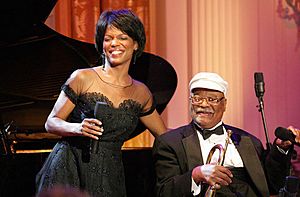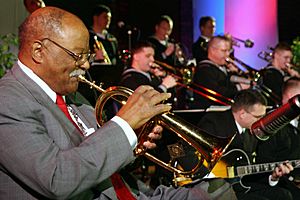Clark Terry facts for kids
Quick facts for kids
Clark Terry
|
|
|---|---|
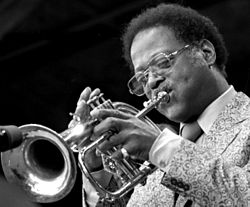
Terry at the 1981 Monterey Jazz Festival (Photo: Brian McMillen).
|
|
| Background information | |
| Born | December 14, 1920 St. Louis, Missouri, United States |
| Died | February 21, 2015 (aged 94) Pine Bluff, Arkansas, United States |
| Genres | Jazz, swing, bebop, hard bop |
| Occupation(s) | Musician, composer |
| Instruments | Trumpet, flugelhorn |
| Years active | 1940s–2015 |
| Labels | Prestige, Pablo, Candid, Mainstream, Impulse! |
| Associated acts | Charlie Barnet, Count Basie, Bob Brookmeyer, Clifford Brown, Eddie "Lockjaw" Davis, Duke Ellington, Dizzy Gillespie, Milt Jackson, J.J. Johnson, Quincy Jones, Yusef Lateef, Charles Mingus, Blue Mitchell, Oliver Nelson, Oscar Peterson, Lalo Schifrin, Billy Taylor |
Clark Terry (born December 14, 1920 – died February 21, 2015) was an amazing American jazz musician. He played the trumpet and was one of the first to use the flugelhorn in jazz music. Clark Terry was also a great teacher and is part of the NEA Jazz Masters group, which is a big honor for jazz artists.
He played with many famous bands and musicians. These included Charlie Barnet (in 1947), Count Basie (from 1948 to 1951), and Duke Ellington (from 1951 to 1959). He also performed with Quincy Jones and Oscar Peterson. From 1962 to 1972, he was a member of The Tonight Show Band, a very popular TV show band. Clark Terry's music career lasted over 70 years! He made more than 900 recordings, making him one of the most recorded jazz musicians ever. He also helped many young musicians, like Quincy Jones, Miles Davis, and Herbie Hancock.
Contents
Early Life and Music Beginnings
Clark Terry was born in St. Louis, Missouri, on December 14, 1920. His parents were Clark Virgil Terry Sr. and Mary Terry. He went to Vashon High School. In the early 1940s, he started his music career playing in local clubs. During World War II, he served in the United States Navy as a bandsman. His very first instrument was the valve trombone.
A Star on the Rise
Clark Terry became well-known in the late 1940s and 1950s. During this time, he worked a lot with Duke Ellington. He played in many of Ellington's special music pieces.
After leaving Ellington's band in 1959, Clark became even more famous around the world. He joined the National Broadcasting Company (NBC) as a staff musician. This was a big deal because Clark Terry was the first African American musician to be a regular member of a band on a major US television network.
He also recorded music with large groups like the London Symphony Orchestra. He played with many high school and college bands too. Clark Terry also led his own small groups, from duos to octets. He even had two big bands: Clark Terry's Big Bad Band and Clark Terry's Young Titans of Jazz. You can find many of his instruments, posters, awards, and recordings at the Clark Terry Archive. This special collection is at William Paterson University in New Jersey.
In 2004, Clark Terry appeared as himself on Little Bill, a children's TV show. He lived in different places like Bayside, Queens and Corona, Queens in New York. Later, he moved to Haworth, New Jersey, and then to Pine Bluff, Arkansas.
His life story was written in a book in 2011. This book shows how good he was at telling stories and his funny sense of humor. It talks about his early years traveling and playing music. He faced challenges like segregation and played in many different places. Through it all, he developed a unique and special way of playing music.
In 2014, a documentary film called Keep on Keepin' On was released. This movie followed Clark Terry for four years. It showed how he mentored a young, blind piano player named Justin Kauflin. Clark helped Justin get ready for a big international music competition.
Clark Terry's own website says he was "one of the most recorded jazz artists in history." He even performed for eight different American Presidents!
His Final Years and Legacy
Clark Terry passed away on February 21, 2015. He had been receiving special care for his health.
Many people shared their thoughts about Clark Terry after he died. Peter Keepnews from The New York Times said Clark was known for his perfect musicianship. He was loved for his playful spirit and how well he could adapt to different music styles. His sound on both the trumpet and the flugelhorn was very unique. He helped make the flugelhorn a popular jazz instrument.
Martin Chilton, writing in the UK's The Daily Telegraph, mentioned that Clark Terry was a music educator. He had a deep and lasting impact on jazz music. Clark became a mentor to many jazz players. These included famous names like Miles Davis, Wynton Marsalis, and Quincy Jones.
In 2005, jazz trumpeter Scotty Barnhart interviewed Clark Terry. Scotty said Clark was "one of the most incredibly versatile musicians to ever live." He called him "a jazz trumpet master that played with the greatest names in the history of the music."
Awards and Honors
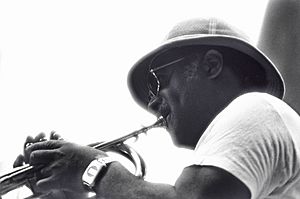
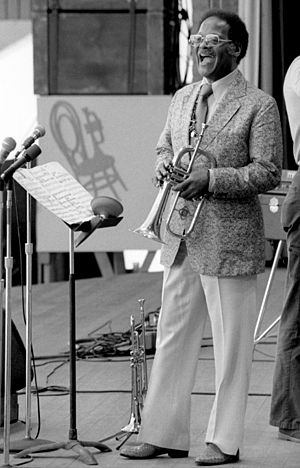
Clark Terry received more than 250 awards, medals, and honors during his life. Some of these include:
- He was added to the Jazz at Lincoln Center Nesuhi Ertegun Jazz Hall of Fame in 2013.
- He received the 2010 Grammy Lifetime Achievement Award. He also had two Grammy certificates and three Grammy nominations.
- He is in the Down Beat Jazz Hall of Fame.
- He won the National Endowment for the Arts Jazz Master Award in 1991.
- He received sixteen honorary doctorates from different universities.
- He was given "Keys to several cities," which is a special honor from a city.
- He served as a Jazz Ambassador for the United States Department of State. This meant he toured in the Middle East and Africa to share jazz music.
- He even received a knighthood in Germany.
- He was honored by the Phi Mu Alpha Sinfonia Fraternity in 1985.
- He received the French Order of Arts and Letters in 2000.
- A life-sized wax figure of him is in the Black World History Museum in St. Louis.
- He was added to the St. Louis Walk of Fame in 1996.
- He won the NARAS Present's Merit Award in 2005.
- The Jazz Journalists Association named him Trumpeter of the Year in 2005.
See also
 In Spanish: Clark Terry para niños
In Spanish: Clark Terry para niños


